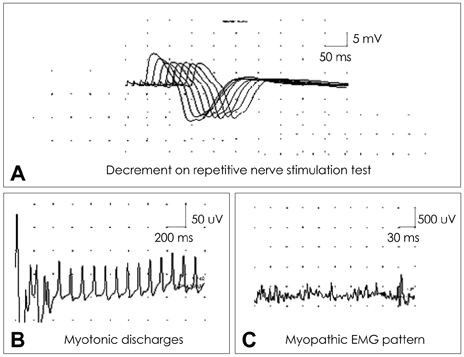J Clin Neurol.
2013 Apr;9(2):130-132. 10.3988/jcn.2013.9.2.130.
The Coexistence of Myasthenia Gravis and Myotonic Dystrophy Type 2 in a Single Patient
- Affiliations
-
- 1Neurology Clinic, Department for Neuromuscular Disorders, Clinical Center of Serbia, Belgrade, Serbia. ananikolic74@yahoo.com
- 2Faculty of Biology, Genetics Department, University of Belgrade, Belgrade, Serbia.
- KMID: 2179174
- DOI: http://doi.org/10.3988/jcn.2013.9.2.130
Abstract
- BACKGROUND
Myasthenia gravis (MG) and myotonic dystrophy type 2 (DM2) are rare disorders individually, and their coexistence in the same patient is very rare. We present a patient in which these two diseases coexisted.
CASE REPORT
The patient complained of diplopia, fluctuating limb weakness, and difficulties in swallowing and speaking. A neurological examination revealed diplopia, facial, weakness of the neck and proximal limb muscles, dysphagia, dysphonia, and myotonia. The patient's mother had DM2 and her maternal grandfather had cataracts. MG was confirmed in our patient by positive results for neostigmine and a repetitive nerve stimulation test, and elevated serum anti-acetylcholine-receptor antibodies, while DM2 was confirmed by electromyography and genetic testing. The patient improved remarkably after treatment with anticholinesterases, corticosteroids, and azathioprine.
CONCLUSIONS
This is the second reported case of the coexistence of DM2 and MG in the same patient. Since the symptoms of these two diseases overlap it is very important to keep in mind the possibility of their coexistence, so that MG is not overlooked in patients with a family history of myotonic dystrophy.
Keyword
MeSH Terms
-
Adrenal Cortex Hormones
Antibodies
Cataract
Cholinesterase Inhibitors
Deglutition
Deglutition Disorders
Diplopia
Dysphonia
Electromyography
Extremities
Genetic Testing
Humans
Mothers
Muscles
Muscular Diseases
Myasthenia Gravis
Myotonia
Myotonic Dystrophy
Neck
Neostigmine
Neurologic Examination
Adrenal Cortex Hormones
Antibodies
Cholinesterase Inhibitors
Neostigmine
Figure
Reference
-
1. Schoen RT. Myasthenia gravis and myotonic dystrophy in a 13-year-old girl. G. Milton Shy Award Essay, 1976. Neurology. 1977. 27:546–549.
Article2. de los Angeles Avaria M, Kleinsteuber K, Novoa F, Faundez P, Carvallo P. Myotonic dystrophy in a female with myasthenia gravis. Pediatr Neurol. 2007. 36:421–423.
Article3. Maytal J, Spiro AJ, Sinnar S, Moshe SL. The coexistence of myasthenia gravis and myotonic dystrophy in one family. Neuropediatrics. 1987. 18:8–10.
Article4. Karagoz ET, Midi I, Tanridag T. Coexistence of myasthenia gravis and myotonic dystrophy in a thyrotoxicosis patient. Internet J Neurol. 2008. 9:8.5. Feyma T, Carter GT, Weiss MD. Myotonic dystrophy type 1 coexisting with myasthenia gravis and thymoma. Muscle Nerve. 2008. 38:916–920.
Article6. Benito-León J, Porta-Etessam J, Díaz de Bustamante A. Myasthemia gravis and myotonic dystrophy in the same patient. Rev Neurol. 2001. 32:498.7. Bamberg C, Deschauer M, Tews DS, Claus D. Coincidence of myasthenia gravis and myotonic dystrophy type 2. Klin Neurophysiol. 2008. 39:267–270.
Article8. Tieleman AA, Knoop H, van de Logt AE, Bleijenberg G, van Engelen BG, Overeem S. Poor sleep quality and fatigue but no excessive daytime sleepiness in myotonic dystrophy type 2. J Neurol Neurosurg Psychiatry. 2010. 81:963–967.
Article9. Matsumoto H, Sugiyama T, Ito M, Yachi A. Occurrence of myasthenia gravis in a patient with congenital myotonia. J Neurol Sci. 1982. 57:83–88.
Article


